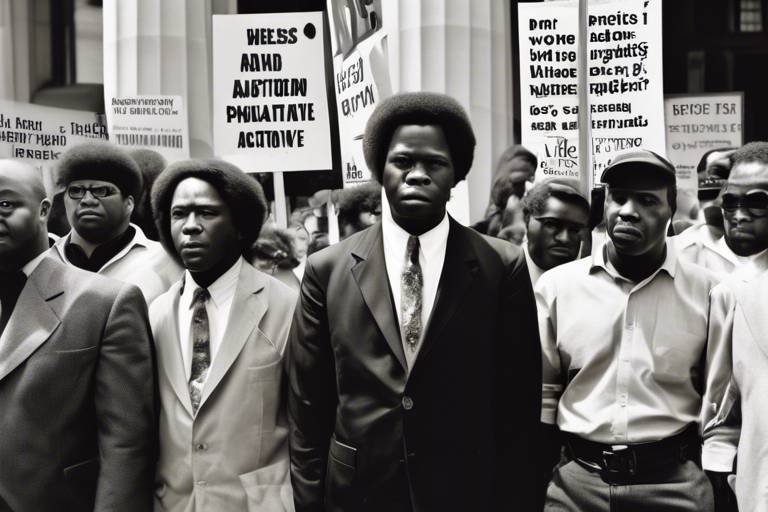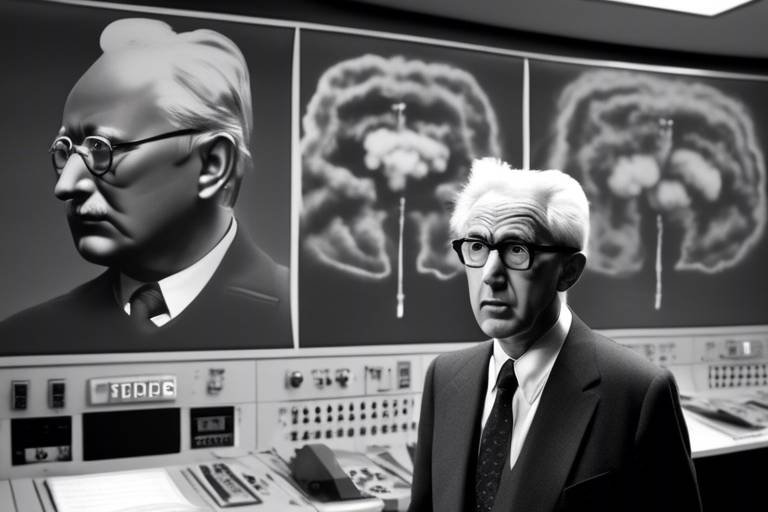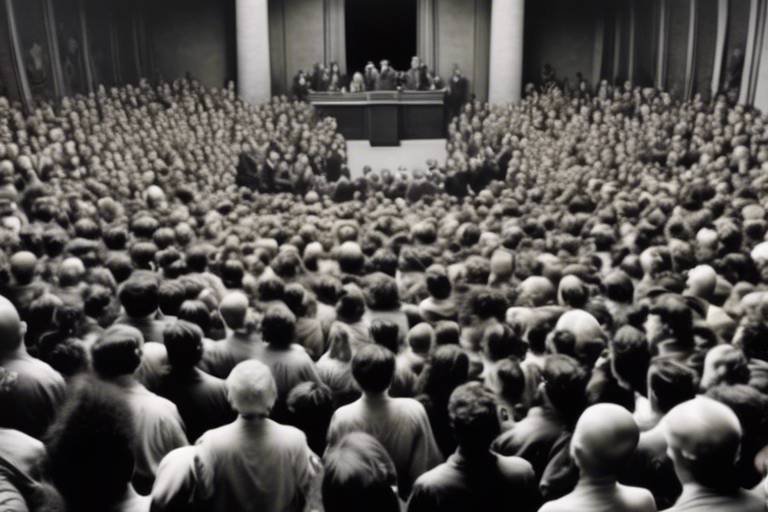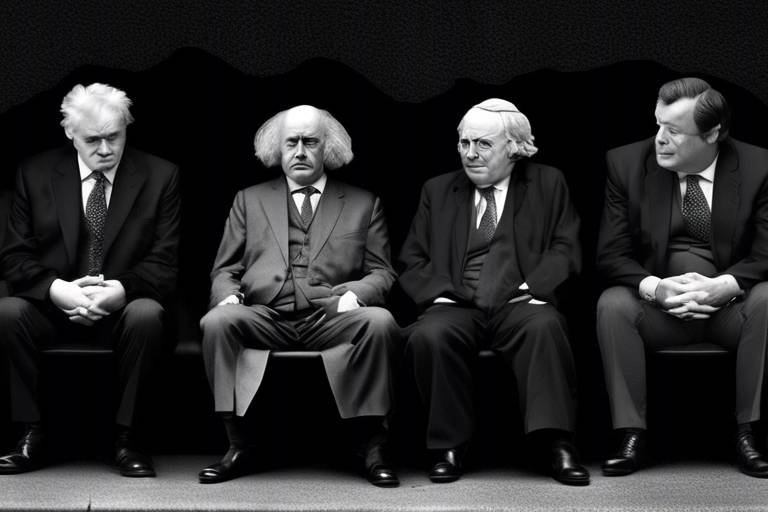Can the Philosophy of Pacifism Reshape Politics?
The idea of pacifism as a guiding principle in politics may seem like a distant dream to some, but its potential to reshape our political landscape is both profound and necessary. Imagine a world where conflicts are resolved through dialogue rather than violence, where leaders prioritize peace over power. This isn’t just a fantasy; it’s a vision that has been championed by various thinkers and activists throughout history. The philosophy of pacifism offers a framework for approaching political issues with compassion, understanding, and a commitment to nonviolence. But how exactly can this ideology influence political systems today?
At its core, pacifism advocates for the resolution of disputes without resorting to violence. This principle can be transformative, especially in an age where political polarization and conflict seem rampant. By emphasizing empathy and dialogue, pacifism challenges the traditional notions of power and governance, urging leaders to consider the human cost of their decisions. In a world where every action has a ripple effect, adopting a pacifist approach to politics could lead to more sustainable and equitable solutions to pressing global issues.
Moreover, the historical context of pacifism in political movements provides a rich tapestry of examples that demonstrate its effectiveness. From the Civil Rights Movement in the United States to anti-colonial struggles across the globe, pacifism has played a crucial role in advocating for justice and equality. Key figures like Martin Luther King Jr. and Mahatma Gandhi have shown that nonviolent resistance can dismantle oppressive systems and inspire widespread change. Their legacies remind us that peace is not merely the absence of war, but a proactive stance that seeks to build bridges rather than walls.
However, the implementation of pacifism in politics is not without its challenges. In a world where aggression often seems to yield quicker results, the slow and steady approach of pacifism can be perceived as ineffective or naive. Critics argue that in the face of tyranny and injustice, pacifism may fall short. Yet, history teaches us that the most enduring changes often arise from persistent, peaceful efforts rather than violent uprisings. The question remains: can the principles of pacifism be integrated into modern governance to create a more just society?
As we explore the relevance of pacifism in today’s political climate, it’s essential to consider its application in various spheres, including international relations and grassroots movements. Nonviolent approaches in diplomacy can lead to more constructive outcomes, fostering cooperation over conflict. Grassroots movements, often powered by ordinary citizens, embody the spirit of pacifism by advocating for social change through peaceful means. These initiatives remind us that every voice matters, and collective action rooted in nonviolence can lead to significant political shifts.
In conclusion, the philosophy of pacifism holds the potential to reshape politics in meaningful ways. By prioritizing dialogue, empathy, and nonviolence, we can challenge the status quo and pave the way for a more peaceful future. As we continue to navigate the complexities of governance, let us not forget the power of pacifism to inspire change and foster a world where peace is not just an ideal, but a reality.
- What is pacifism? Pacifism is the belief that disputes should be resolved without violence and that peace should be prioritized in all situations.
- How has pacifism influenced historical movements? Pacifism has been a driving force in various movements, such as the Civil Rights Movement, where leaders like Martin Luther King Jr. used nonviolent resistance to challenge injustice.
- What are the challenges of implementing pacifism in politics? Challenges include the perception that nonviolence is ineffective and the tendency for aggressive tactics to yield quicker results in political conflicts.
- Can pacifism be applied to modern international relations? Yes, pacifism can inform diplomatic strategies, promoting conflict resolution through dialogue and cooperation instead of aggression.
- What role do grassroots movements play in pacifism? Grassroots movements often embody pacifist principles by advocating for social change through peaceful means, demonstrating the power of collective action.

The Principles of Pacifism
Pacifism is more than just a stance against violence; it is a profound philosophy that challenges the very fabric of political discourse and societal norms. At its core, pacifism embodies the belief that conflicts should be resolved through peaceful means rather than through warfare or coercion. This principle is not merely an abstract idea; it is grounded in ethical considerations that promote respect for human life and dignity. The essence of pacifism is captured in the conviction that all individuals possess an inherent right to live free from fear and violence. This perspective compels us to rethink our approach to conflict and governance, urging us to prioritize dialogue over discord.
One of the foundational tenets of pacifism is the idea of nonviolence. This principle advocates for the use of peaceful methods, such as negotiation, dialogue, and civil disobedience, to address grievances and seek justice. Nonviolence is not a passive response; rather, it is an active commitment to creating change without resorting to aggression. For instance, consider the impact of peaceful protests. They have the power to mobilize communities, raise awareness, and challenge oppressive systems without causing harm. The effectiveness of such strategies lies in their ability to appeal to the moral conscience of society, often leading to greater support for the cause.
Another critical aspect of pacifism is its focus on empathy and understanding. Pacifists advocate for seeing the humanity in others, even in adversaries. This approach fosters a culture of compassion, where the objective is not to defeat an opponent but to engage in meaningful dialogue that can bridge divides. By promoting empathy, pacifism encourages individuals to consider the perspectives and experiences of others, paving the way for more constructive and collaborative solutions to conflicts.
Furthermore, pacifism challenges the notion of power as domination. Traditional political systems often equate power with the ability to impose one's will through force. In contrast, pacifism redefines power as the capacity to inspire, unite, and uplift communities. This shift in perspective is crucial, as it allows for a more inclusive and democratic approach to governance. By prioritizing collective well-being over individual gain, pacifism advocates for systems that reflect the values of equity and justice.
Despite its noble principles, pacifism is not without its critics. Detractors often argue that pacifism can be naive or ineffective in the face of aggression and tyranny. However, history has shown us that nonviolent movements can lead to significant political and social change. Figures like Martin Luther King Jr. and Mahatma Gandhi exemplified how pacifist principles could dismantle systems of oppression and inspire millions. Their legacies serve as a testament to the power of peaceful resistance and the potential for pacifism to reshape political landscapes.
In summary, the principles of pacifism call for a radical rethinking of how we approach conflict and governance. By promoting nonviolence, empathy, and a redefined sense of power, pacifism offers a compelling alternative to traditional political paradigms. As we navigate the complexities of contemporary governance, embracing these principles may not only enhance political discourse but also foster a more just and peaceful society.

Historical Context of Pacifism in Politics
The historical context of pacifism in politics is rich and multifaceted, illustrating how nonviolent principles have shaped significant political movements throughout history. Pacifism, at its core, advocates for resolving conflicts through peaceful means rather than through violence or warfare. This ideology has found its way into various political contexts, influencing leaders and movements that sought change without resorting to bloodshed. From the early days of the anti-war movements to the impactful civil rights campaigns of the 20th century, the history of pacifism is replete with examples of how peaceful resistance can bring about substantial political transformation.
One of the most notable instances of pacifism in action was during the early 20th century when activists began to challenge the norms of militarism and war. Figures like Leo Tolstoy and Mohandas Gandhi emerged as pivotal voices advocating for nonviolence. Their philosophies not only inspired individuals but also laid the groundwork for future movements. For instance, Gandhi's approach to nonviolent resistance, or Satyagraha, became a cornerstone for various civil rights movements around the globe. This method emphasized the power of peaceful protest and civil disobedience as tools for social change, demonstrating that moral authority could triumph over brute force.
During the American Civil Rights Movement, the principles of pacifism were brought to the forefront by leaders such as Martin Luther King Jr.. He famously stated, "Nonviolence is a powerful and just weapon," which encapsulated the essence of how pacifism could be wielded effectively in the struggle against racial injustice. King and his contemporaries organized peaceful marches, sit-ins, and boycotts, all designed to challenge systemic racism without resorting to violence. The success of these actions not only highlighted the effectiveness of pacifism in political activism but also led to significant legislative changes, such as the Civil Rights Act of 1964.
| Key Figures | Movements | Impact |
|---|---|---|
| Mohandas Gandhi | Indian Independence Movement | Led to India's independence from British rule |
| Martin Luther King Jr. | Civil Rights Movement | Significant advancements in racial equality in the U.S. |
| Leo Tolstoy | Anti-War Activism | Influenced pacifist movements globally |
However, the journey of pacifism in politics has not been without its challenges. Throughout history, pacifist movements have often faced backlash from those who favor more aggressive tactics. Critics argue that pacifism can be ineffective in the face of brutal oppression, questioning whether peaceful methods can truly achieve lasting change. Yet, the historical successes of nonviolent movements suggest that while pacifism may not always yield immediate results, its long-term effects can be profound and transformative.
As we examine the historical context of pacifism in politics, it becomes clear that the ideology is not merely an abstract concept but a practical approach that has been successfully implemented in various political landscapes. The lessons learned from these historical movements continue to resonate today, reminding us of the potential for peaceful resistance to create meaningful change.
- What is pacifism? Pacifism is the belief that disputes should be settled without violence and that war is unjustifiable.
- How has pacifism influenced political movements? Pacifism has inspired numerous political movements, encouraging leaders to adopt nonviolent strategies to achieve social change.
- Who are some notable pacifist leaders? Key figures include Mohandas Gandhi, Martin Luther King Jr., and Leo Tolstoy, all of whom advocated for nonviolent resistance.
- What are the challenges faced by pacifist movements? Pacifist movements often encounter skepticism and resistance, particularly from those who believe that violence is necessary to combat oppression.

Pacifism in the Civil Rights Movement
The Civil Rights Movement of the 1950s and 1960s stands as a powerful testament to the effectiveness of pacifism in driving political change. At its core, this movement was not just about achieving legal equality for African Americans; it was a profound moral struggle that sought to transform the very fabric of American society. Leaders like Martin Luther King Jr. embraced the philosophy of nonviolence, drawing inspiration from Gandhi's teachings, which emphasized the power of love and understanding over hatred and aggression. This approach was revolutionary, as it challenged the prevailing notion that violence was a necessary means to an end in the quest for justice.
King's adherence to pacifism was evident in his famous “Letter from Birmingham Jail,” where he articulated the necessity of nonviolent protest as a response to systemic racism. He believed that nonviolent resistance could expose the injustices of segregation and discrimination, compelling the nation to confront its moral failings. By employing peaceful methods, such as sit-ins, marches, and boycotts, activists were able to draw public attention to their cause without resorting to violence, which often led to further oppression and backlash.
One of the most iconic moments of the Civil Rights Movement was the March on Washington for Jobs and Freedom in 1963, where King delivered his legendary “I Have a Dream” speech. This event not only showcased the unity and determination of thousands of individuals advocating for civil rights but also emphasized the effectiveness of peaceful assembly as a tool for political change. The march was a culmination of years of nonviolent activism, demonstrating how pacifist principles could mobilize communities and inspire a nation.
Moreover, the success of the Civil Rights Movement can be attributed to its ability to foster a sense of solidarity among diverse groups. By promoting a message of peace and understanding, leaders were able to unite individuals from various backgrounds, creating a powerful coalition that transcended racial and socioeconomic barriers. This collective effort illustrated how pacifism could serve as a unifying force in the struggle for justice, ultimately leading to significant legislative changes, such as the Civil Rights Act of 1964 and the Voting Rights Act of 1965.
However, it's important to recognize that the path of pacifism was not without its challenges. Activists faced violent opposition from segregationists, law enforcement, and even governmental authorities. Yet, the commitment to nonviolence became a source of strength, allowing the movement to maintain its moral high ground. The courage displayed by individuals who faced brutality without retaliation highlighted the profound impact of pacifist philosophy in the fight for civil rights.
In conclusion, the Civil Rights Movement serves as a powerful example of how pacifism can reshape political landscapes. By adhering to nonviolent principles, activists were able to challenge deeply entrenched systems of oppression, create lasting change, and inspire future generations to pursue justice through peaceful means. The lessons learned from this era continue to resonate today, reminding us of the enduring power of nonviolence in the quest for equality and human rights.
- What is pacifism? Pacifism is the belief that violence is unjustifiable under any circumstances and that disputes should be settled by peaceful means.
- How did pacifism influence the Civil Rights Movement? Leaders like Martin Luther King Jr. utilized nonviolent strategies to challenge racial injustice, demonstrating that peaceful protests could lead to significant political change.
- What are some examples of nonviolent protest? Examples include sit-ins, marches, and boycotts, all of which were used effectively during the Civil Rights Movement.
- Can pacifism be effective in modern politics? Yes, many contemporary movements continue to adopt pacifist principles to advocate for social change and address issues such as climate change and social justice.

Influence of Gandhi's Philosophy
Gandhi's philosophy of nonviolence, known as Satyagraha, has had a profound impact on political movements around the world, particularly in the context of the Civil Rights Movement in the United States. His teachings emphasized the power of truth and nonviolent resistance as tools for social change. Gandhi believed that true strength lies not in physical force but in the ability to confront injustice with compassion and steadfastness. This approach resonated deeply with leaders like Martin Luther King Jr., who adopted Gandhi's principles in their struggle for racial equality.
One of the most significant aspects of Gandhi's philosophy is the idea that nonviolence is not merely a tactic, but a way of life. This principle encourages individuals to cultivate inner peace and resilience, thereby enabling them to face oppression without resorting to violence. Gandhi argued that violence only begets more violence, creating a cycle of hatred and retribution. Instead, he advocated for a transformative approach to conflict, where adversaries could find common ground through dialogue and understanding.
Gandhi's influence extended beyond the realm of civil rights; it inspired a myriad of movements worldwide, from anti-apartheid struggles in South Africa to the more recent climate justice movements. His emphasis on grassroots activism and community involvement helped shape the strategies employed by activists aiming to bring about systemic change. For instance, during the Civil Rights Movement, King's adoption of nonviolent direct action was a direct reflection of Gandhi's teachings. King believed that by peacefully protesting against unjust laws, they could expose the moral failures of the system and inspire change.
Moreover, Gandhi's philosophy also highlights the importance of personal responsibility in the pursuit of justice. He encouraged individuals to reflect on their own actions and attitudes, urging them to embody the change they wished to see in the world. This notion of self-reflection is crucial in understanding how pacifist principles can be integrated into political activism. Gandhi's legacy teaches us that effective change starts at the individual level, and it is through collective action rooted in nonviolence that society can progress.
To illustrate the impact of Gandhi's philosophy on the Civil Rights Movement, consider the following table that outlines key events and their connections to his teachings:
| Event | Gandhi's Influence | Outcome |
|---|---|---|
| Montgomery Bus Boycott (1955) | Inspired by Gandhi's nonviolent resistance | Led to the desegregation of public buses |
| March on Washington (1963) | Nonviolent demonstration for civil rights | Highlighted the demand for racial equality |
| Selma to Montgomery March (1965) | Emphasis on peaceful protest | Resulted in the Voting Rights Act |
In conclusion, Gandhi's philosophy of nonviolence has not only shaped the strategies of civil rights activists but has also provided a framework for addressing social injustices across various movements. By advocating for love, empathy, and understanding, Gandhi's teachings continue to inspire those who seek to challenge oppression without resorting to violence. His legacy serves as a reminder that while the path of pacifism may be challenging, it is ultimately a powerful avenue for achieving lasting change.
- What is Satyagraha? Satyagraha is Gandhi's principle of nonviolent resistance, emphasizing truth and moral integrity in the pursuit of justice.
- How did Gandhi influence Martin Luther King Jr.? King adopted Gandhi's nonviolent strategies and teachings to lead the Civil Rights Movement in the United States.
- Can pacifism be effective in modern politics? Yes, many contemporary movements still draw on pacifist principles to advocate for social change through nonviolent means.

Lessons Learned from Nonviolent Protests
Nonviolent protests have played a pivotal role in shaping political landscapes throughout history, offering invaluable lessons that resonate even today. One of the most striking lessons is the power of unity. When individuals come together for a common cause, their collective strength can challenge even the most formidable systems of oppression. Take, for instance, the Civil Rights Movement in the United States. Leaders like Martin Luther King Jr. emphasized that a unified front, grounded in shared values and mutual respect, could amplify their message and create a formidable force for change.
Another significant lesson is the importance of strategic planning. Nonviolent movements often require meticulous organization and foresight. Activists need to anticipate potential backlash and prepare for various scenarios. The successful Montgomery Bus Boycott, for example, was not just a spontaneous act of defiance; it was the result of careful planning and community engagement. Organizers ensured that participants had alternative transportation options, which helped maintain momentum and solidarity.
Furthermore, the effectiveness of nonviolent protests lies in their ability to engage public consciousness. By employing peaceful methods, movements can draw attention to their cause without alienating potential allies. This approach often leads to broader public support, as seen during the protests led by Mahatma Gandhi in India. His philosophy of nonviolence not only rallied the Indian populace but also garnered international sympathy and support against colonial rule.
Additionally, nonviolent protests teach us about the significance of empathy and moral high ground. When protesters maintain a peaceful demeanor, they often position themselves as the moral compass of a society. This can sway public opinion and create a sense of urgency for change. A striking example is the Salt March, where Gandhi and his followers marched to the sea to produce salt, defying British laws. The act was a powerful symbol of resistance and highlighted the injustices of colonialism, winning hearts and minds globally.
Moreover, the lessons learned from nonviolent protests underscore the importance of adaptability. Movements must be willing to evolve their strategies based on the political climate and societal responses. For instance, the Black Lives Matter movement has utilized social media to mobilize support and spread awareness rapidly, showcasing how modern technology can enhance traditional nonviolent strategies.
In summary, the lessons from nonviolent protests are rich and multifaceted. They teach us about the power of unity, the necessity of strategic planning, the importance of engaging public consciousness, the value of empathy, and the need for adaptability. As we reflect on these lessons, it becomes clear that nonviolent approaches can indeed reshape political discourse and action, paving the way for a more just and equitable society.
- What is pacifism? Pacifism is a philosophy that advocates for nonviolence and seeks to resolve conflicts without the use of force.
- How has pacifism influenced political movements? Pacifism has inspired numerous political movements, emphasizing nonviolent resistance as a means to achieve social change.
- Can nonviolent protests be effective? Yes, nonviolent protests have proven effective in various historical contexts, often leading to significant political and social changes.
- What are some key examples of nonviolent protests? Examples include the Civil Rights Movement in the U.S., Gandhi's Salt March, and the anti-apartheid movement in South Africa.
- How can I get involved in nonviolent movements today? You can get involved by joining local organizations, participating in peaceful demonstrations, and advocating for social justice through various platforms.

Challenges to Implementing Pacifism in Politics
Implementing pacifism in politics is like trying to swim upstream in a river filled with obstacles. While the philosophy promotes peace and nonviolence, the reality of political systems often stands in stark contrast to these ideals. One of the primary challenges is the deeply ingrained culture of aggression and power dynamics that dominate most political landscapes. Politicians often feel compelled to adopt a confrontational stance to assert their authority or to respond to threats, making it difficult for pacifist principles to gain traction.
Moreover, the fear of vulnerability plays a significant role in this resistance. Many leaders worry that adopting a pacifist approach could be perceived as weakness, leading to a loss of power or influence. This fear can create a vicious cycle where aggression begets aggression, making it even harder for peaceful approaches to be taken seriously. Additionally, the media often glorifies conflict and sensationalizes violent confrontations, further entrenching the notion that power must be demonstrated through force rather than dialogue.
Another challenge lies in the diverse interpretations of pacifism itself. Within the pacifist community, there are varying beliefs about what constitutes effective nonviolent action. Some advocate for complete non-engagement with violent systems, while others believe in participating within the system to effect change. This lack of consensus can lead to fragmentation and weaken the overall movement, as different factions may struggle to unite under a common cause. For instance, the debate around whether to support certain political candidates who may not fully align with pacifist ideals can create rifts within activist groups.
Furthermore, the political landscape is often influenced by external factors such as global conflicts, economic instability, and social unrest. These factors can pressure governments to adopt militaristic policies as a means of maintaining order or asserting dominance. In such an environment, pacifism can seem impractical or naive, leading to skepticism about its effectiveness. The challenge, therefore, is not just about advocating for peace, but also about convincing others that nonviolent methods can lead to sustainable solutions.
To illustrate these challenges, consider the following table which outlines some common obstacles faced by pacifist movements:
| Challenge | Description |
|---|---|
| Culture of Aggression | Political systems often prioritize power and confrontation over dialogue and peace. |
| Fear of Vulnerability | Leaders may perceive pacifism as weakness, fearing loss of authority. |
| Diverse Interpretations | Different views on nonviolent action can lead to fragmentation within the movement. |
| External Pressures | Global conflicts and economic instability can push governments towards militaristic policies. |
In conclusion, while the philosophy of pacifism offers a compelling vision for a more peaceful political landscape, the path to its implementation is fraught with challenges. Overcoming these hurdles requires not only a commitment to nonviolence but also a strategic approach that addresses the fears, misconceptions, and external pressures that hinder its acceptance. By fostering dialogue and building coalitions, pacifist movements can begin to carve out a space for their ideals in the often tumultuous arena of politics.
- What is pacifism? Pacifism is the belief that violence is unjustifiable and that disputes should be settled through peaceful means.
- Can pacifism be effective in politics? Yes, history shows that nonviolent movements have successfully led to significant political change.
- What are some examples of pacifism in action? Notable examples include the Civil Rights Movement in the United States and the Indian independence movement led by Gandhi.
- What challenges do pacifists face today? Challenges include cultural aggression, fears of vulnerability, diverse interpretations of pacifism, and external political pressures.

Modern-Day Applications of Pacifism
In today's fast-paced and often tumultuous world, the principles of pacifism are more relevant than ever. As we navigate through conflicts—whether they be social, political, or international—the call for nonviolent solutions resonates deeply with many individuals and movements. Pacifism is not merely an abstract philosophy; it has practical applications that can reshape how we address some of the most pressing issues facing humanity. From grassroots movements advocating for social justice to diplomatic strategies aimed at conflict resolution, the spirit of pacifism is alive and well.
Take, for instance, the way grassroots movements have embraced pacifist principles. These community-led initiatives often prioritize nonviolent resistance as a way to challenge injustice. They serve as a reminder that ordinary people can instigate change without resorting to violence. Movements such as Black Lives Matter and climate activism have utilized peaceful protests to draw attention to their causes, demonstrating the power of collective action grounded in pacifist ideology. By employing tactics such as sit-ins, marches, and social media campaigns, these movements illustrate that change can be achieved through dialogue rather than discord.
Additionally, the role of pacifism in international relations cannot be overstated. As nations grapple with complex geopolitical tensions, the need for nonviolent diplomacy becomes increasingly critical. Countries that adopt pacifist strategies often find themselves at the forefront of conflict resolution efforts. For example, initiatives that promote dialogue over military intervention can lead to more sustainable peace agreements. By focusing on understanding and compromise rather than aggression, nations can foster a global environment conducive to harmony.
Moreover, educational institutions are increasingly incorporating pacifist principles into their curricula. Schools and universities are teaching students the importance of conflict resolution through nonviolent means. Programs that emphasize empathy, communication, and negotiation skills are vital in cultivating a new generation of leaders who prioritize peace. These educational efforts reflect a growing recognition that the future of politics may very well hinge on our ability to resolve differences without violence.
While the applications of pacifism are promising, they are not without challenges. Many contemporary movements face significant pushback from established power structures that view nonviolent approaches as ineffective or naive. However, history has shown us that the road to change is often paved with obstacles. The resilience of pacifism lies in its ability to adapt and evolve in response to these challenges. By learning from past successes and failures, modern movements can refine their strategies and continue to advocate for change through peaceful means.
As we observe these various applications of pacifism, it becomes clear that the principles of nonviolence offer a viable path forward. Whether in grassroots activism, international diplomacy, or education, the essence of pacifism challenges us to rethink how we engage with the world. It invites us to consider the profound impact of our choices and actions, encouraging us to strive for a future where peace is not just an ideal, but a lived reality.
- What is pacifism? Pacifism is a belief that disputes should be settled without violence, advocating for nonviolent approaches in both personal and political contexts.
- How can pacifism be applied in modern politics? Pacifism can be applied through grassroots movements, nonviolent protests, and diplomatic efforts that prioritize dialogue over conflict.
- What are some historical examples of pacifism influencing politics? Key examples include the Civil Rights Movement in the United States and Gandhi's nonviolent resistance against British rule in India.
- What challenges does pacifism face today? Challenges include resistance from established political structures, societal norms favoring aggression, and the perception that nonviolence is ineffective.

Pacifism in International Relations
When we think about international relations, the first images that often come to mind are those of heated debates, military strategies, and diplomatic tensions. However, what if we flipped the script and approached these complex interactions through the lens of pacifism? Pacifism, at its core, advocates for resolving conflicts without resorting to violence. This philosophy has the potential to reshape how nations interact, emphasizing dialogue, understanding, and cooperation over confrontation. Imagine a world where countries prioritize peaceful negotiations over military might; it could lead to a more stable and harmonious global community.
One of the key aspects of pacifism in international relations is its emphasis on nonviolent conflict resolution. Traditional approaches often focus on deterrence and military strength, but pacifist strategies encourage nations to engage in open dialogue and seek common ground. This can be particularly effective in resolving disputes that, if left unchecked, could escalate into full-blown conflicts. For instance, during the Cold War, there were numerous opportunities where diplomatic channels could have been utilized more effectively, potentially averting crises.
Moreover, pacifism promotes the idea that understanding cultural differences and fostering relationships can lead to long-term peace. Through initiatives like cultural exchange programs and international cooperation on global issues such as climate change, nations can build trust and mitigate tensions. The more we understand each other, the less likely we are to perceive one another as threats. This concept is beautifully illustrated by the work of organizations like the United Nations, which aims to create a platform for dialogue and collaboration among member states.
However, it's essential to acknowledge that implementing pacifism in international relations is not without its challenges. Some argue that pacifism can be perceived as weakness, leading to exploitation by more aggressive nations. This brings us to the delicate balance between strength and diplomacy. While it's crucial to stand firm against aggression, there’s also a need for a robust diplomatic strategy that prioritizes peaceful resolutions. The key lies in finding a middle ground where nations can defend their interests while still advocating for peace.
To illustrate the impact of pacifism in international relations, consider the following table that highlights some notable examples:
| Event | Year | Outcome |
|---|---|---|
| Camp David Accords | 1978 | Peace agreement between Egypt and Israel |
| South Africa's Transition | 1994 | End of apartheid through negotiations |
| Iran Nuclear Deal | 2015 | Diplomatic agreement to limit nuclear weapons |
These examples showcase how pacifism can lead to significant political breakthroughs, proving that nonviolent approaches can yield tangible results. The ripple effects of such agreements extend beyond the immediate parties involved, fostering a culture of peace that can influence other nations to adopt similar strategies.
As we look to the future, the role of pacifism in international relations will only become more critical. With global challenges like climate change, pandemics, and economic inequality, nations must find ways to collaborate rather than compete. Embracing pacifism could pave the way for innovative solutions that prioritize the well-being of all humanity. After all, in a world increasingly interconnected, the stakes are too high for us to cling to outdated paradigms of conflict and aggression.
In conclusion, while the path of pacifism in international relations is fraught with challenges, its potential benefits are undeniable. By fostering a culture of dialogue and understanding, nations can work towards a more peaceful and cooperative global community. The question remains: are we ready to embrace this transformative approach?
- What is pacifism? Pacifism is the belief that conflicts should be resolved without violence and that nonviolent means are preferable to aggression.
- How can pacifism influence international relations? Pacifism can lead to peaceful negotiations, conflict resolution, and stronger diplomatic ties between nations.
- What are some historical examples of pacifism in politics? Notable examples include the Civil Rights Movement, Gandhi's nonviolent resistance, and various peace treaties throughout history.
- What challenges does pacifism face in modern politics? Challenges include perceptions of weakness, aggressive state actors, and the complexities of global power dynamics.
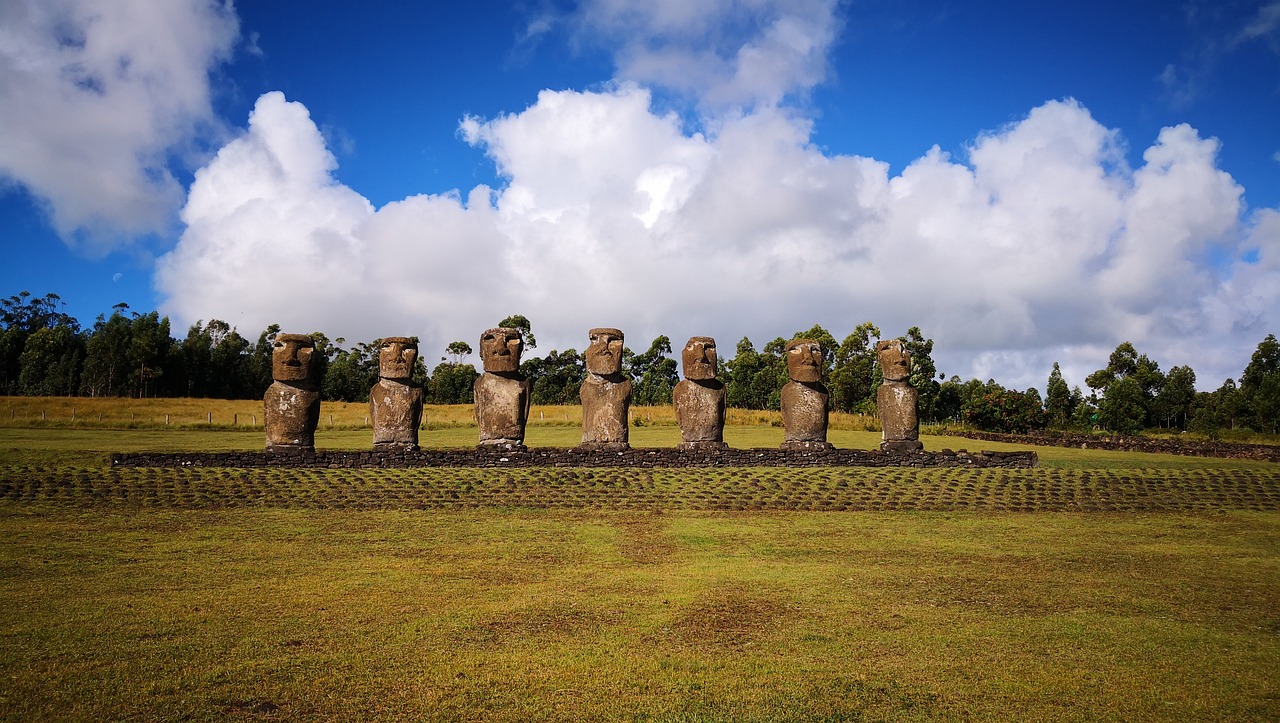
Grassroots Movements and Pacifism
Grassroots movements are often the unsung heroes of social change, embodying the very essence of pacifism in their approach to political activism. These movements, which arise from the local level and are driven by ordinary people, emphasize community engagement and the power of collective action. Unlike traditional political campaigns that may rely on aggressive tactics or high-profile endorsements, grassroots movements thrive on the principles of nonviolence and inclusivity. They remind us that profound change can start from the ground up, echoing the sentiment that every voice matters.
One of the most compelling aspects of grassroots movements is their ability to mobilize communities around shared values and goals. For instance, consider the Fight for $15 movement, which advocates for a living wage for fast-food workers. This initiative began with a small group of workers who believed they deserved better pay and working conditions. Through peaceful protests, strikes, and community support, they have sparked a nationwide conversation about wage inequality. Such movements illustrate how grassroots efforts can align with pacifist principles, utilizing nonviolent resistance to achieve significant political and social outcomes.
Moreover, grassroots movements often utilize creative strategies to raise awareness and garner support. They employ tactics such as:
- Community organizing and mobilization
- Peaceful demonstrations and sit-ins
- Social media campaigns to spread their message
- Collaborations with local organizations to amplify their reach
These approaches not only promote awareness but also cultivate a sense of ownership among community members. When individuals see their neighbors taking action, it inspires a ripple effect that can lead to larger movements. This interconnectedness is a hallmark of pacifism, as it fosters dialogue and understanding rather than division and hostility. The success of these initiatives often hinges on their ability to maintain a nonviolent stance, even in the face of opposition.
However, it is essential to acknowledge the challenges that grassroots movements face in a political landscape that can often be resistant to change. The entrenched interests of powerful entities can pose significant obstacles, making it difficult for grassroots organizations to gain traction. Yet, history has shown us that persistence, coupled with a commitment to nonviolence, can lead to transformative outcomes. The Civil Rights Movement and the anti-apartheid struggle in South Africa are prime examples of how grassroots efforts rooted in pacifism can dismantle systemic injustice.
As we look to the future, the role of grassroots movements in promoting pacifism remains vital. In a world increasingly fraught with division and conflict, these movements serve as beacons of hope, demonstrating that peaceful resistance can lead to meaningful change. By continuing to advocate for social justice through nonviolent means, grassroots organizations embody the spirit of pacifism and remind us all of the power of collective action.
Q: What are grassroots movements?
A: Grassroots movements are community-led initiatives that seek to bring about social or political change, often starting from the local level and relying on the participation of ordinary people.
Q: How do grassroots movements embody pacifism?
A: These movements typically employ nonviolent strategies, focusing on dialogue, peaceful protests, and community engagement to achieve their goals without resorting to aggression.
Q: Can grassroots movements be effective in today's political climate?
A: Yes, despite facing challenges, grassroots movements have historically proven to be effective in creating social change by mobilizing communities and raising awareness on critical issues.
Q: What are some examples of successful grassroots movements?
A: Notable examples include the Civil Rights Movement, the Fight for $15, and various environmental justice initiatives that have successfully mobilized communities around shared causes.
Frequently Asked Questions
- What is pacifism?
Pacifism is a belief system that advocates for nonviolence and opposes the use of force to resolve conflicts. It emphasizes the importance of peaceful coexistence and seeks to address issues through dialogue and understanding rather than aggression.
- How can pacifism influence political systems?
Pacifism can reshape political systems by promoting policies that prioritize diplomacy over military action. It encourages leaders to consider peaceful solutions and fosters a culture of tolerance and respect, potentially leading to more stable and just societies.
- What historical examples showcase pacifism in politics?
One notable example is the Civil Rights Movement in the United States, where leaders like Martin Luther King Jr. employed nonviolent resistance to fight for racial equality. Additionally, Mahatma Gandhi's philosophy of nonviolence inspired many political movements around the world.
- How did Gandhi's philosophy influence modern movements?
Gandhi's principles of nonviolence have had a lasting impact on various social justice movements. His teachings encourage activists to pursue change through peaceful protests and civil disobedience, emphasizing the moral high ground in their fight for justice.
- What challenges do pacifists face in contemporary politics?
Pacifists often encounter significant challenges, such as political resistance, societal apathy, and the prevailing belief that violence is sometimes necessary for achieving goals. These obstacles can make it difficult to implement pacifist principles in governance.
- Are there modern examples of pacifism in action?
Yes! There are numerous contemporary movements that embody pacifist ideals, such as grassroots initiatives advocating for social change through nonviolent means. These movements often focus on issues like environmental justice, human rights, and community empowerment.
- How does pacifism relate to international relations?
In international relations, pacifism promotes diplomatic solutions to conflicts rather than military interventions. It encourages countries to engage in dialogue, fostering peaceful coexistence and collaboration on global issues like climate change and human rights.




